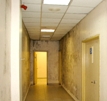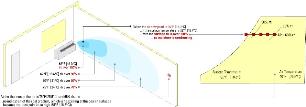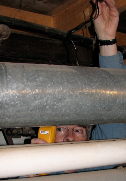
Tracking Moisture with Surface RH
- By Jerry Laws
- May 01, 2009
 Moisture is the key for mold formation, and effective moisture control within a building is key to preventing it. Pinpointing the moisture is a bit more technical than you might think, however. Lew Harriman, co-author of the second edition of the "ASHRAE Guide for Buildings in Hot and Humid Climates," was just back from visiting a mold remediation project, a two-story outpatient clinic in Malaysia, when interviewed for this article March 30. The book's Chapter 5, titled "Avoiding Bugs, Mold & Rot," discusses common mistakes made in building design and operation that lead to moisture intrusion and mold. The authors suggest all mold problems are preventable.
Moisture is the key for mold formation, and effective moisture control within a building is key to preventing it. Pinpointing the moisture is a bit more technical than you might think, however. Lew Harriman, co-author of the second edition of the "ASHRAE Guide for Buildings in Hot and Humid Climates," was just back from visiting a mold remediation project, a two-story outpatient clinic in Malaysia, when interviewed for this article March 30. The book's Chapter 5, titled "Avoiding Bugs, Mold & Rot," discusses common mistakes made in building design and operation that lead to moisture intrusion and mold. The authors suggest all mold problems are preventable.
"Yes, but I think that the most important message, and I hope it came through in that chapter, is that there's very rarely a single cause of mold problems. Usually, you have to have two or three things go wrong in a fairly significant way before you're likely to have a mold problem. And [addressing] it requires a multi-disciplinary effort between architects, HVAC engineers, and the owners who determine their budgets," said Harriman, who is director of research and consulting for Mason-Grant Consulting (www.masongrant.com) of Portsmouth, N.H.
He said mold situations come down to two concerns: recognizing a problem, then deciding what to do about it. Initially, it is often a question of odor--a musty, earthy odor is likely to indicate moisture, which is likely to indicate mold. "I'd like to encourage the readers not to ignore odors," said Harriman, who noted it can be difficult to determine the extent of a problem. Entering a hotel room in the summer in the United States, for example, one may encounter a musty or dank smell. It probably indicates fungus and bacteria. "Is that a problem? Well, I don't know. It depends," he said. "It's much to be hoped that the U.S. will finally invest a few bucks in research to lock this down a little bit tighter. We know some people are sensitized. But how did they get that way, and exactly what are the levels of exposure to mold which will represent a health hazard for as-yet-unsensitized people? I'm optimistic that this research will happen over the next few years."
 If an odor is apparent after the building cooling system is turned on, there's a good chance things are growing inside that HVAC system. If the odor is less pronounced and does not seem to depend on whether the air-conditioning system is running, then the chances are good it has something to do with excess moisture within the building enclosure. "In all cases, it's a question of locating the moisture," he explained. If the HVAC system is the source, the problem is likely to be found in ductwork, the cooling coil, or a condensate pan. The questions with condensate pans are whether they will drain and, if so, drain to a good place (such as the sanitary drain) or a bad one (such as the carpet in front of the HVAC unit). Noting that condensate drains frequently are "either not connected or not draining effectively," Harriman said it's important to ensure drain lines are clean and drain freely.
If an odor is apparent after the building cooling system is turned on, there's a good chance things are growing inside that HVAC system. If the odor is less pronounced and does not seem to depend on whether the air-conditioning system is running, then the chances are good it has something to do with excess moisture within the building enclosure. "In all cases, it's a question of locating the moisture," he explained. If the HVAC system is the source, the problem is likely to be found in ductwork, the cooling coil, or a condensate pan. The questions with condensate pans are whether they will drain and, if so, drain to a good place (such as the sanitary drain) or a bad one (such as the carpet in front of the HVAC unit). Noting that condensate drains frequently are "either not connected or not draining effectively," Harriman said it's important to ensure drain lines are clean and drain freely.
The second edition of the "ASHRAE Guide" is co-written by Harriman and Joseph Lstiburek, Ph.D., P.Eng., a principal of Building Science Corporation (www.buildingscience.com) and an ASHRAE Fellow. Since 1980, building owners, architects, and engineers have learned and then ignored or forgotten the "the agonizingly expensive lessons of preventing mold and moisture problems in buildings," the authors assert, adding that most owners and design professionals still do not include actions to keep buildings dry in their standard practices.
Chapter 5 offers these suggestions for owners and architects:
- Use roof overhangs, gutters, and wall projections, which avoid as much as 50 percent of the rain load on exterior walls.
- Install sill pan flashing under windows and doors to catch any leak around windows and direct the water back outdoors.
- Clearly establish responsibility for integrating the flashing around windows, doors, and balconies.
- Design and install exterior walls that drain rain and dry quickly.
- Interior wall finish for exterior walls should pass water vapor freely, unlike vinyl wall coverings.
- Install any paper-faced gypsum board with a short gap at the floor so wash water cannot wick up into the board.
Suggestions for the HVAC designer include a broader focus on known HVAC risk factors for mold, bugs, and rot. Harriman and Lstiburek write, "the ventilation air system as designed by the mechanical engineer and operated by the building staff should not add moisture to the building's material or furnishings." Also, ensuring all air duct connections, exhaust duct joints, and air handler cabinets are air-tight will mean a much lower risk of mold because the system will be less likely to pull humid air in through the building enclosure.
Building maintenance is usually less a factor in mold risk, compared to how the building and ventilation system were designed and constructed, Harriman said.
Surface RH as a Diagnostic Tool
 Surface relative humidity, a concept introduced in the first edition of the book, is revisited in the second edition, which became available in January 2009. Moisture content is influenced by surface RH, which is often higher than the humidity of the air in a space because some surfaces stay cooler than the air. Thus, the RH values reported by building automation systems or hand-held instruments are not reliable indicators of mold risk, according to the book.
Surface relative humidity, a concept introduced in the first edition of the book, is revisited in the second edition, which became available in January 2009. Moisture content is influenced by surface RH, which is often higher than the humidity of the air in a space because some surfaces stay cooler than the air. Thus, the RH values reported by building automation systems or hand-held instruments are not reliable indicators of mold risk, according to the book.
Harriman said manufacturers of temperature and RH instruments have been "quite slow" to pick up on the significance of surface RH, and people who operate and maintain buildings often are not familiar with the concept. Harriman and Lstiburek are promoting it as a diagnostic and hope instrument makers will catch on.
"It bridges the gap between HVAC people's understanding of humidity issues and their relationship to mold problems," said Harriman. "The problem is that HVAC people do think about air; they don't think about surfaces. If they don't have high RH in the air, they don't think they're part of the problem. But often, they are, because it's the dew point that matters." A high indoor dew point will result in a high surface RH in an air conditioned building, because the system cools many surfaces, in addition to the air.
As an example, Harriman said, in the Malaysian clinic, the air in the building rarely went above 60 percent RH, even at night, when the systems were off. But the clinic's AC system operated only during occupied hours. During the day, the AC created cold surface temperatures in the building. As humid air entered the building overnight, the indoor dew point rose rapidly because the building was quite leaky and because there was no dehumidification equipment to remove the humidity load from the infiltrating air. Indoor surfaces absorbed that humidity, providing ideal mold growth conditions, every night, Harriman said. It was apparent that interior zones with far too much cooling had much more mold growth than perimeter zones, where the AC system wasn't overcooling the surfaces quite as much.
Assessing Moisture and Remediating Mold
 A thermal camera and a moisture meter are two basic tools OSH professionals and other investigators use to locate and quantify a moisture problem. Thermal cameras work well because indoors, in almost all cases, moist materials are just slightly cooler than similar materials that are dry, Harriman said. "The problem that often comes with thermal cameras is that you can be fooled into thinking that you're looking at moisture, when in fact you're only looking at surface temperature differences. That's a really, really important point. And the only way to be sure you have a moist material instead of just a cool material is to measure the suspect spot with a moisture meter."
A thermal camera and a moisture meter are two basic tools OSH professionals and other investigators use to locate and quantify a moisture problem. Thermal cameras work well because indoors, in almost all cases, moist materials are just slightly cooler than similar materials that are dry, Harriman said. "The problem that often comes with thermal cameras is that you can be fooled into thinking that you're looking at moisture, when in fact you're only looking at surface temperature differences. That's a really, really important point. And the only way to be sure you have a moist material instead of just a cool material is to measure the suspect spot with a moisture meter."
He said a lawyer friend of his explained it this way after attending one of Harriman's presentations: "The thermal camera indicts . . . but the moisture meter convicts."
Thermal cameras are highly useful for HVAC professionals and professionals handling the cleanup of buildings damaged by water, both to ensure their repairs have addressed the entire problem and to ensure they are paid for the entirety of the work they've done. "One shouldn't accept a thermal image without a moisture content reading in the area where the contractor says there's a problem. There are just too many other reasons for surfaces to be cold," he cautioned.
Harriman said EPA issued guidelines for mold remediation in 2003 that are clean, simple, and evenhanded--so much so that, if a safety and health professional realizes EPA's guidelines are not being followed on an active project, it's time to find another remediation contractor, he said.
The American Industrial Hygiene Association offers a much more comprehensive guide: "Recognition, Evaluation, and Control of Indoor Mold," known as "the green book" because of its cover. Edited by Bradley Prezant, Donald Weekes, and J. David Miller, the book contains 20 chapters. EPA's guidelines provide simple, basic tools, while AIHA's book is an excellent, comprehensive reference for mold, Harriman said.